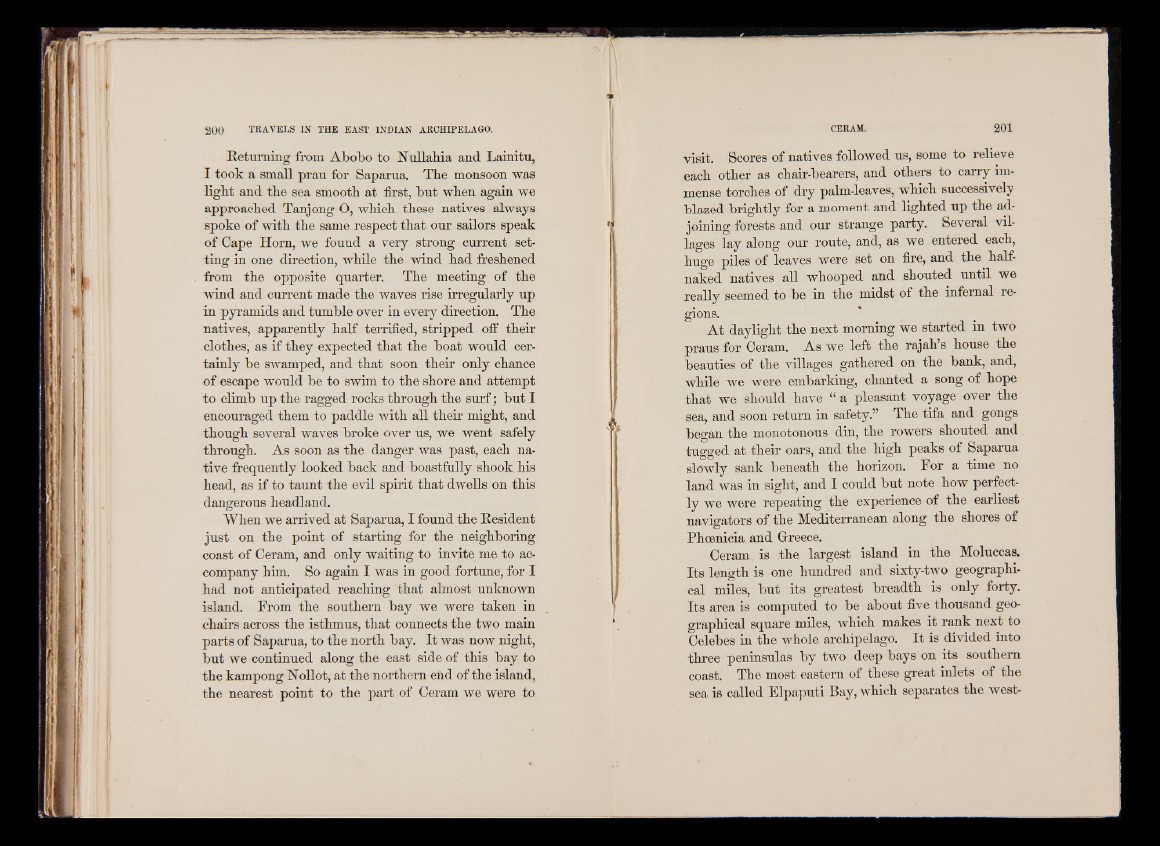
Returning from Abobo to Nullabia and Lainitu,
I took a small prau for Saparua. Tbe monsoon was
ligbt and tbe sea smooth at first, but wben again we
approached Tanjong O, which these natives always
spoke of with the same respect that our sailors speak
of Cape Horn, we found a very strong current setting
in one direction, while the wind had freshened
from the opposite quarter. The meeting of the
wind and current made the waves rise irregularly up
in pyramids and tumble over in every direction. The
natives, apparently half terrified, stripped off their
clothes, as if they expected that the boat would certainly
be swamped, and that soon their only chance
of escape would be to swim to the shore and attempt
to climb up the ragged rocks through the surf; but I
encouraged them to paddle with all their might, and
though several waves broke over us, we went safely
through. As soon as the danger was past, each native
frequently looked back and boastfully shook his
head, as if to taunt the evil spirit that dwells on this
dangerous headland.
When we arrived at Saparua, I found the Resident
just on the point of starting for the neighboring
coast of Ceram, and only waiting to invite me to accompany
him. So again I was in good fortune, for I
had not anticipated reaching that almost unknown
island. From the southern bay we were taken in
chairs across the isthmus, that connects the two main
parts of Saparua, to the north bay. It was now night,
but we continued along the east side of this bay to
the kampong Nollot, at the northern end of the island,
the nearest point to the part of Ceram we were to
visit. Scores of natives followed us, some to relieve
each other as chair-bearers, and others to carry immense
torches of dry palm-leaves, which successively
blazed brightly for a moment and lighted up the adjoining
forests and our strange party. Several villages
lay along our route, and, as we entered each,
huge piles of leaves were set on fire, and the half-
naked natives all whooped and shouted until we
really seemed to be in the midst of the infernal regions.
At daylight the next morning we started in two
praus for Ceram. As we left the rajah’s house the
beauties of the villages gathered on the bank, and,
while we were embarking, chanted a song of hope
that we should have “ a pleasant voyage over the
sea, and soon return in safety.” The tifa and gongs
began the monotonous din, the rowers shouted and
tugged at their oars, and the high peaks of Saparua
slowly sank beneath the horizon. For a time no
land was in sight, and I could but note how perfectly
we were repeating the experience of the earliest
navigators of the Mediterranean along the shores of
Phoenicia and Greece.
Ceram is the largest island in the Moluccas.
Its length is one hundred and sixty-two geographical
miles, but its greatest breadth is only forty.
Its area is computed to be about five thousand geographical
square miles, which makes it rank next to
Celebes in the whole archipelago. It is divided into
three peninsulas by two deep bays on its southern
coast. The most eastern of these great inlets of the
sea is called Elpaputi Bay, which separates the west